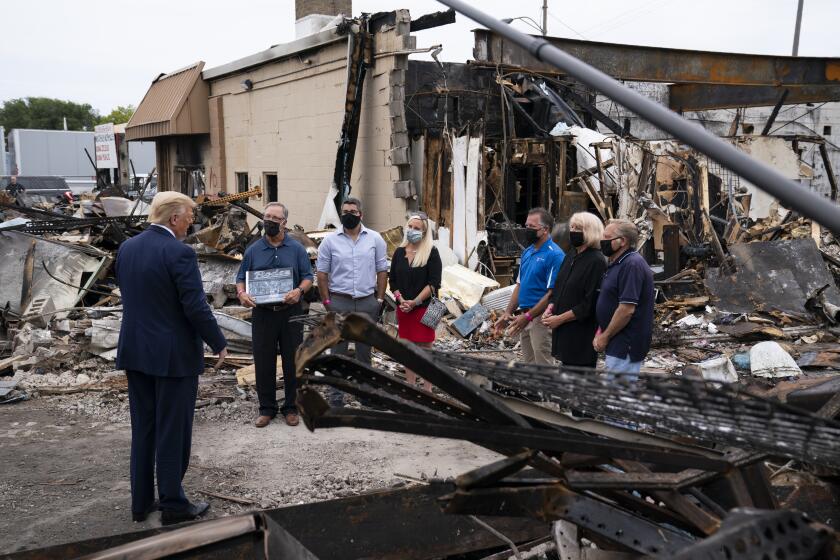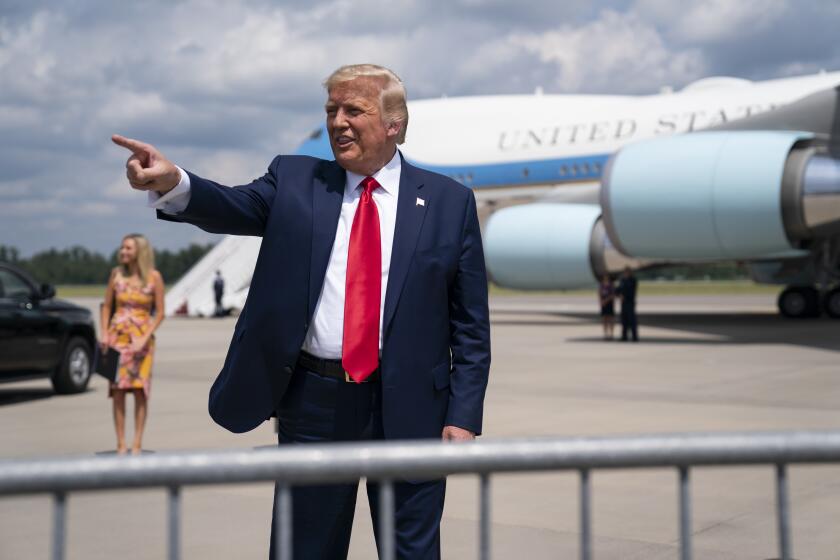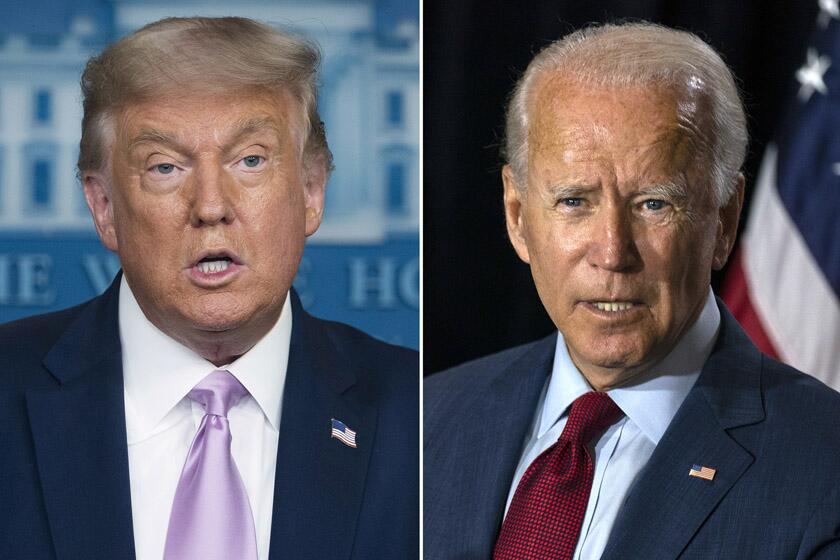New Trump ads stoke racial bias among white people in Minnesota and Wisconsin
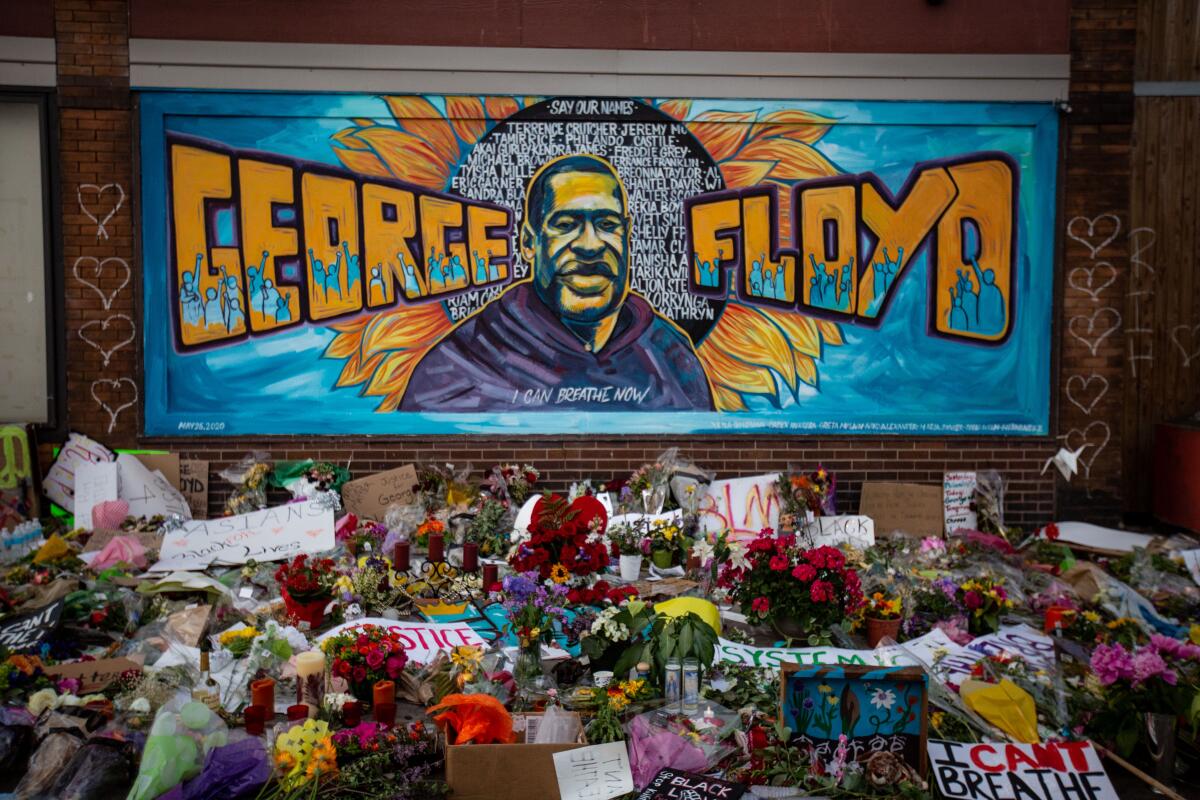
- Share via
President Trump resumed television advertising after the Republican National Convention with two racially charged commercials airing in Minnesota and Wisconsin, battleground states racked by social upheaval after recent violent police encounters with Black men.
Trump’s ads show how he is trying to replicate his 2016 success in stirring racial resentments of white voters in Upper Midwest regions that have struggled for decades with a painful decline in manufacturing jobs.
His Minnesota spot shows people leaping through broken storefront windows with arms full of stolen merchandise and protesters watching a Minneapolis police precinct burn down during unrest that erupted after George Floyd, a Black man, was killed in May by a white officer who knelt on his neck for more than eight minutes.
“Lawless criminals terrorize Minneapolis. Joe Biden takes a knee,” a woman says of Trump’s Democratic challenger before an image of Democratic congresswoman Ilhan Omar of Minneapolis wearing a hijab flashes on screen. “The weak response from Biden and radicals like Ilhan Omar has led to chaos and violence.”
Joe Biden and President Trump might be fighting over riots and law and order, but Black activists in California are undeterred in planning more protests against police brutality.
The ad Trump is airing in neighboring Wisconsin highlights demonstrators last month in Kenosha hurling debris and fireworks at police in riot gear after an officer in the small city outside Milwaukee shot another Black man, Jacob Blake, seven times in the back in front of his three children. Blake, who was paralyzed from the waist down, remains hospitalized.
Trump’s false depiction of Biden as a champion of arsonists and vandals who have marred a small portion of the recent nationwide protests against police brutality and racism led the former vice president to respond with his own ad in Minnesota, Wisconsin and other battleground states.
“I want to make it absolutely clear: Rioting is not protesting,” Biden says in the ad. “Looting is not protesting. It’s lawlessness plain and simple, and those who do it should be prosecuted.”
After months of warning of a “rigged” election against him, President Trump now suggests his supporters vote by mail and then in person. Election officials say the practice would be illegal, and could lead to delays and disputes at polling places in November.
Biden also accused Trump of fueling the unrest himself by refusing to discourage armed right-wing vigilantes from joining police confronting Black Lives Matter protesters.
“Fires are burning, and we have a president who fans the flames,” Biden says in the spot. “He can’t stop the violence, because for years he’s fomented it.”
David Paul Kuhn, author of “The Hardhat Riot,” a book on white blue-collar voters, said the Biden response was essential to blunting the impact of Trump’s racial appeals in the Great Lakes states.
“I think the Democrats should be concerned if Biden takes his foot off the gas on taking control of the ‘law and order’ issue and not letting it be Trump’s,” he said.
Minnesota and Wisconsin are among the whitest states in America. Minnesota’s population is 79% white; Wisconsin’s is 81%. The nation as a whole is 60% white, 19% Latino, 13% Black and 6% Asian American.
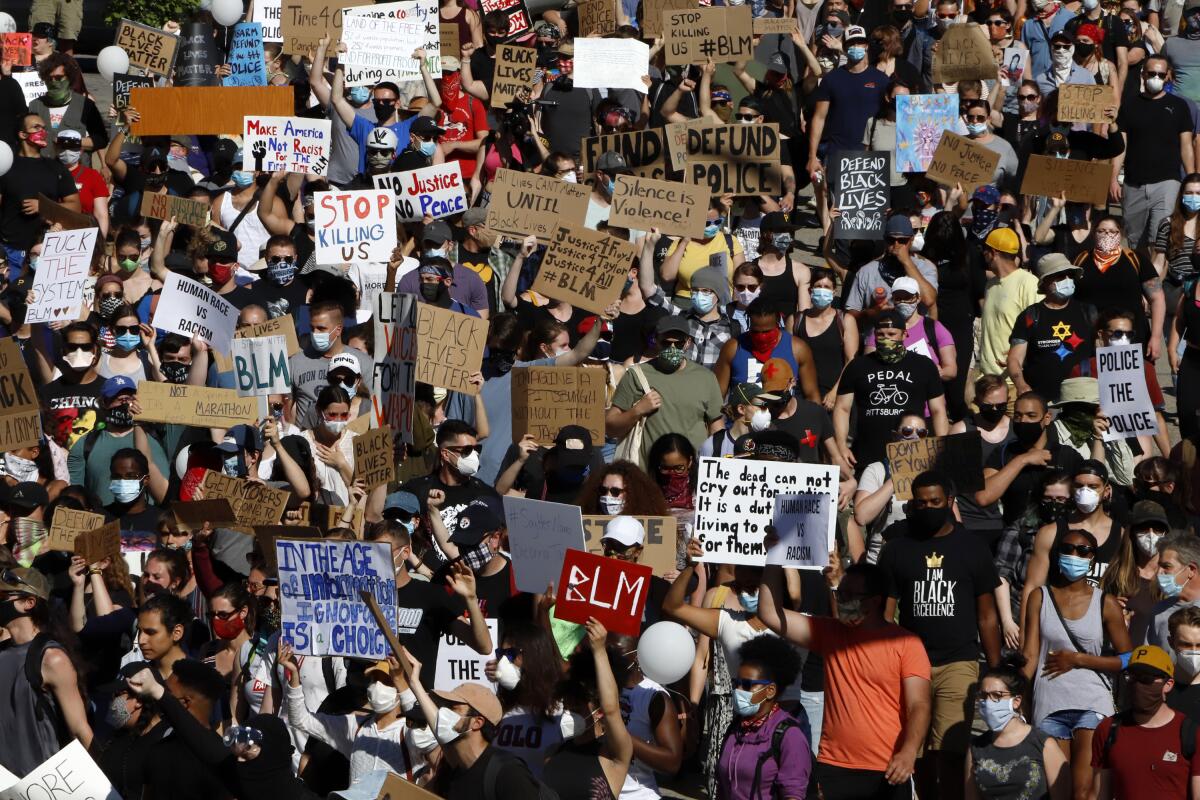
Trump’s new ads have run more than 1,800 times over the last week in Minneapolis, Rochester and Duluth in Minnesota and in Milwaukee, Madison, Green Bay, La Crosse and Wausau in Wisconsin, according to Advertising Analytics, an ad tracking firm. The wide reach suggests that rural and small-town voters are as much a target as those in the suburbs. Facebook variations of the ads have been viewed overwhelmingly by men, according to the social media company.
Trump won rural areas by enormous margins in 2016 and hopes to do so again in part by drawing thousands of votes from people who normally skip presidential elections.
It’s unclear whether his racial appeals can win back suburban voters, especially women with college degrees, who have been abandoning the Republican Party in droves during Trump’s presidency.
Marquette Law School polling shows that support among Wisconsin’s white voters for Black Lives Matter protests dropped from 59% in June to 45% last month, just before the shooting of Blake in Kenosha. At the same time, white voters’ disapproval of Trump’s handling of the protests remained high, ticking upward from 55% to 57%.
Anna Greenberg, a Democratic pollster, is skeptical about the effectiveness of Trump’s approach, especially with suburban women. They want “calm and order,” she said, but see Trump as contributing to chaos.
“They feel like we’re more divided than ever, and they want us to not be this way,” she said. “Conflict is scary. Racial conflict is even scarier.”
In 2016, Trump’s nativist appeals were crucial to his narrow wins in Wisconsin, Michigan and Pennsylvania, the states that sealed his electoral college majority even as he finished 2.9 million votes behind Hillary Clinton nationwide.
Trump lost Minnesota by just a 1.5% margin. No Republican presidential candidate has won Minnesota since Richard Nixon in 1972, but Trump has targeted it again.
His effort to reap political gain from the racial turmoil over Floyd’s killing recalled his attempts in 2016 to tap into white voters’ discomfort with the tens of thousands of Somali immigrants in the Minneapolis area.
At a Minneapolis rally two days before the 2016 election, Trump lamented “large numbers of Somali refugees coming into your state without your knowledge, without your support or approval, and with some of them then joining ISIS and spreading their extremist views all over our country.” He gave no specifics to back up his charges.
Trump portrayed himself as a staunch ally of Black Americans at the party convention. But his new ads reflect his opposition to the largely peaceful Black Lives Matter demonstrations of millions of Americans denouncing racial bias in the criminal justice system.
Trump’s racial appeals in battleground states scattered around the country are fraught with risk as he struggles to gain support in the suburbs of cities such as Phoenix; Detroit; Philadelphia; Charlotte, N.C.; Atlanta; Houston; and Orlando, Fla.
A look at where President Trump and Joe Biden stand on key issues in the 2020 election, including healthcare, immigration, police reform and climate.
“He’s trying to use these incidents of violence to unnerve white voters, particularly in the suburbs,” said Lawrence Jacobs, a political scientist at the University of Minnesota.
It’s not just the sporadic outbreaks of violence at the protests that could work in Trump’s favor, he said. Jacobs suggested that some of the rhetoric that Minneapolis liberals have used recently to question white privilege was alienating rural and small-town white voters long beset by economic troubles.
“The push for racial justice is certainly speaking eloquently about Black identity, and understandably so,” he said. “There’s not much appreciation for how it’s also triggering white identity, and it’s creating a tremendous opportunity for Donald Trump to swoop in.”
More to Read
Get the L.A. Times Politics newsletter
Deeply reported insights into legislation, politics and policy from Sacramento, Washington and beyond. In your inbox three times per week.
You may occasionally receive promotional content from the Los Angeles Times.
